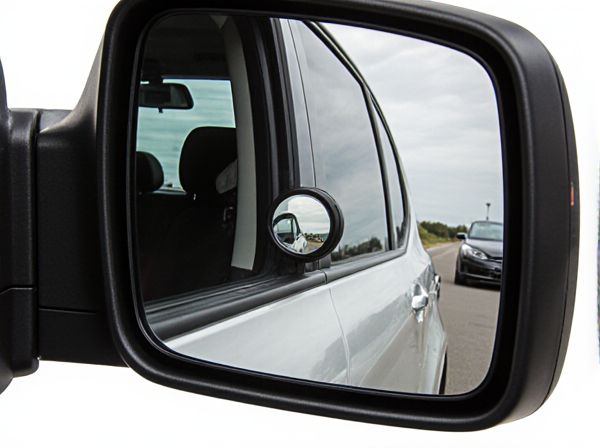
Photo illustration: Blind Spot Mirror vs Wide-Angle Mirror
Blind spot mirrors enhance your safety by providing a small, convex mirror attachment that expands the field of view, helping eliminate areas not visible through standard mirrors. Wide-angle mirrors offer a broader perspective directly integrated into the mirror design, minimizing blind spots with a larger, convex surface. Choosing the right mirror depends on your vehicle and driving needs, ensuring your visibility is maximized for safer lane changes and maneuvering.
Table of Comparison
| Feature | Blind Spot Mirror | Wide-Angle Mirror |
|---|---|---|
| Purpose | Eliminates blind spots beside the vehicle | Expands overall field of view behind the vehicle |
| Design | Small convex mirror attached to main mirror | Larger, curved mirror covering wider view area |
| Field of View | 20-40 degrees, focused on blind spots | Up to 120 degrees, broad rear visibility |
| Installation | Easy glue-on or clip-on addition | Usually integrated or full replacement mirror |
| Cost | Low, affordable accessory | Higher, may require professional installation |
| Best For | Drivers needing improved blind spot awareness | Drivers seeking comprehensive rear vision |
Understanding Blind Spot Mirrors
Blind spot mirrors are small, convex mirrors designed to eliminate vehicle blind spots by providing a wider field of vision directly adjacent to the side mirrors. Unlike wide-angle mirrors that offer an extended view horizontally, blind spot mirrors specifically target angled zones where vehicles commonly go unseen, enhancing safety during lane changes. Proper installation and positioning of blind spot mirrors maximize their effectiveness in reducing collisions caused by unseen vehicles in blind spots.
Overview of Wide-Angle Mirrors
Wide-angle mirrors provide an expanded field of view by increasing the mirror's curvature, allowing drivers to see more of their surroundings compared to standard mirrors. These mirrors effectively reduce blind spots by capturing a wider perspective of adjacent lanes and behind the vehicle. Their enhanced visibility improves safety during lane changes and merges, making them a popular choice for both passenger vehicles and commercial trucks.
Key Differences Between Blind Spot and Wide-Angle Mirrors
Blind spot mirrors are small, convex mirrors designed to eliminate the blind spots by providing a limited yet focused field of view on specific areas near the vehicle. Wide-angle mirrors, in contrast, offer a broader perspective across a wider area but can cause a distorted image due to their extensive curvature. The key difference lies in blind spot mirrors enhancing targeted visibility directly in blind spots, while wide-angle mirrors increase overall peripheral awareness with less detail.
Benefits of Using Blind Spot Mirrors
Blind spot mirrors enhance driving safety by providing a focused view of areas not visible in standard side mirrors, significantly reducing the risk of collisions during lane changes. These small convex mirrors offer precise visibility of adjacent lanes and blind spots, helping drivers detect vehicles or obstacles quickly. Unlike wide-angle mirrors, blind spot mirrors minimize distortion while maintaining an accurate representation of nearby objects for better spatial awareness.
Advantages of Wide-Angle Mirrors for Drivers
Wide-angle mirrors provide drivers with an expanded field of view, significantly reducing blind spots and enhancing overall road safety by allowing better awareness of surrounding vehicles, pedestrians, and obstacles. These mirrors minimize the need for excessive head movements, promoting quicker and safer lane changes while improving reaction times in complex driving environments. Their increased visibility is particularly advantageous during merging, parking, and navigating tight spaces, offering a comprehensive perspective that standard blind spot mirrors cannot match.
Installation Process: Blind Spot Mirror vs Wide-Angle Mirror
Blind spot mirrors typically require simple adhesive backing for quick, tool-free installation on side mirrors, making them a convenient choice for most vehicles. Wide-angle mirrors often involve a more complex installation process, which may include brackets or clamps to securely attach the mirror, ensuring stability during driving. Choosing between these mirrors depends on the ease of installation and personal preference for adjustable or fixed mounting options.
Safety Considerations and Visibility Enhancements
Blind spot mirrors significantly improve driver safety by eliminating hidden areas that traditional mirrors cannot cover, reducing the risk of collisions during lane changes. Wide-angle mirrors expand the field of view by up to 120 degrees, allowing drivers to detect approaching vehicles and obstacles more effectively in low-visibility conditions. Both mirror types complement each other by enhancing situational awareness and decreasing blind spots, thereby increasing overall road safety.
Common Applications for Each Mirror Type
Blind spot mirrors are commonly used on passenger vehicles and motorcycles to enhance visibility in areas not covered by standard side mirrors, reducing the risk of accidents during lane changes. Wide-angle mirrors are frequently installed on commercial trucks, buses, and large vehicles to provide a broader field of view, allowing drivers to monitor multiple lanes and adjacent areas effectively. Both mirror types are vital for improving safety, with blind spot mirrors targeting specific hidden zones and wide-angle mirrors offering extensive coverage.
User Experiences and Real-World Comparisons
Blind spot mirrors provide enhanced visibility by attaching to the side mirror, reducing dangerous blind spots and improving safety during lane changes. Wide-angle mirrors offer a broader field of view, capturing more peripheral vision but sometimes creating distorted images that can affect depth perception. Users often prefer blind spot mirrors for precise monitoring, while wide-angle mirrors are favored for overall awareness, making the choice dependent on driving habits and specific safety needs.
Choosing the Best Mirror for Your Vehicle
Blind spot mirrors provide focused visibility on specific areas directly beside and behind a vehicle, enhancing safety by reducing blind spots in standard side mirrors. Wide-angle mirrors offer a broader field of view, capturing more peripheral lanes and improving overall situational awareness during lane changes. Choosing the best mirror depends on your driving environment and vehicle type, with blind spot mirrors ideal for targeted visibility and wide-angle mirrors suited for comprehensive coverage.
 caratoz.com
caratoz.com